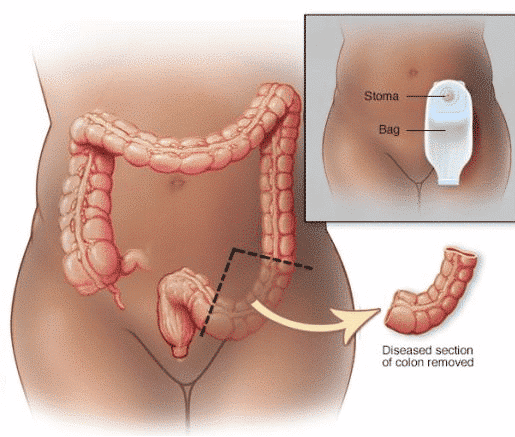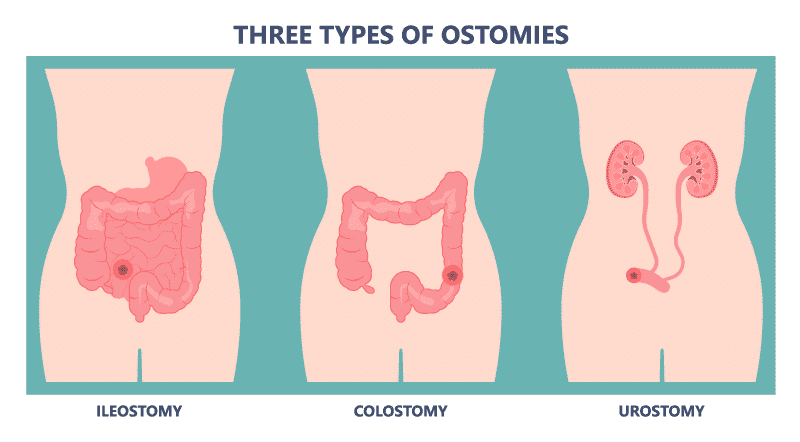
FREE DELIVERY IN USA OVER $120
FREE DELIVERY IN EUROPE OVER $100
What is an Ostomy? This is a very asked question, let’s try to summarize everything in this ostomy post:
Delving into the realm of “What is an Ostomy?” isn’t merely an exploration of a medical procedure, but a segue into a narrative of resilience, rebirth, and reinvention.
An ostomy is a surgical procedure that creates an opening in the body for the discharge of bodily wastes, either from the intestine or from the urinary tract.
This procedure is often necessary when a person cannot eliminate waste normally due to disease, injury, or congenital conditions. The most common types of ostomies are colostomy, ileostomy, and urostomy.
Understanding What is an Ostomy involves knowing why it’s done and how it affects a person’s life. For instance, a colostomy involves the colon and is often required due to complications from diseases like colon cancer.
An ileostomy, involving the small intestine, might be necessary in the case of Crohn’s disease. A urostomy is typically related to bladder diseases or conditions.
People with an ostomy often use special bags attached to their stoma (the opening created in their abdomen) to collect waste. It’s a significant change that requires adjustment and learning, but with proper education and support, those with an ostomy can lead full, active lives.
Discussing What is an Ostomy not only involves the surgical aspect but also the emotional and practical implications for the individual.
An ostomy is a life-changing surgical procedure that involves creating an opening in the body, known as a stoma, to allow waste to exit the body.
This procedure is necessary when certain medical conditions, such as colorectal cancer, inflammatory bowel disease, or bladder cancer, impair the normal functioning of the digestive or urinary systems.
The most common types of ostomies are colostomy, ileostomy, and urostomy, each differing in the part of the body where the stoma is created and the specific reason for the surgery.
Living with an ostomy requires adjustments and adaptation. It’s important for patients to learn about ostomy care, including how to manage and maintain their stoma and use ostomy appliances like bags or pouches.
These appliances are designed to collect waste from the stoma and are a critical part of daily life post-surgery.
Education and support are key for individuals adjusting to an ostomy. Healthcare professionals provide essential guidance, while support groups offer a community of individuals who share similar experiences, offering empathy and practical advice.
Adapting to life with an ostomy can be challenging, but with the right resources and support, individuals can continue to lead active, fulfilling lives.
An ostomy bag, also known as an ostomy pouch, is a crucial medical device used by individuals who have undergone an ostomy procedure. An ostomy—whether it’s a colostomy, ileostomy, or urostomy—requires the creation of a stoma, which is an opening on the abdomen through which waste exits the body. The ostomy bag is attached to the skin around this stoma to collect this waste.
The primary function of an ostomy bag is to safely and hygienically collect bodily wastes, whether it’s stool or urine, that exit through the stoma. These bags are designed to be discreet, secure, and comfortable, allowing individuals with an ostomy to continue with their daily activities without significant interruption.
There are different types of ostomy bags, including one-piece or two-piece systems. In a one-piece system, the ostomy bag and the skin barrier (the part that sticks to the skin) are combined. In a two-piece system, the bag and skin barrier are separate, allowing for easier changing of the bag. The choice of an ostomy bag depends on personal preference, lifestyle, and the type of ostomy.
Living with an ostomy bag requires some adjustments. Individuals need to learn how to properly apply, empty, and care for their ostomy bag.
However, with proper education and support, those with an ostomy can lead a normal and active lifestyle. It’s important for individuals to work closely with healthcare professionals to choose the right ostomy bag and learn how to manage their ostomy effectively.
An ostomy pouch, also commonly referred to as an ostomy bag, is a medical device used by individuals who have undergone an ostomy surgery. This surgery involves creating a stoma, which is an opening on the abdomen that allows waste to exit the body.
The ostomy pouch is attached to the skin around the stoma for the purpose of collecting this waste. It’s an essential component for people with a colostomy, ileostomy, or urostomy, each involving different sections of the digestive or urinary systems.
The primary function of an ostomy pouch is to collect feces or urine that exits through the stoma, providing a hygienic and discreet way to manage bodily waste. These pouches come in various types and styles to suit different needs.
There are one-piece systems, where the pouch and the adhesive skin barrier are combined, and two-piece systems, where the pouch and skin barrier are separate. This allows for flexibility in changing the pouch without removing the skin barrier.
Proper management and care of the ostomy pouch are critical for maintaining skin health and ensuring comfort. This involves knowing how to apply, empty, and dispose of the pouch correctly.
Individuals with an ostomy receive education from healthcare professionals on how to care for their stoma and manage their ostomy pouch effectively. Although it requires adjustments to daily life, many people with an ostomy lead active, normal lives with the help of these specialized medical devices.
1.
A stoma is a medically created opening in the abdomen that allows waste to exit the body. It is a critical part of an ostomy procedure, which is performed when certain medical conditions prevent the normal passage of bodily waste through the intestines or bladder.
Stomas are typically created during surgeries like colostomy, ileostomy, or urostomy, each corresponding to different parts of the digestive or urinary systems.
In a colostomy, the stoma is connected to a part of the colon, allowing feces to bypass the lower part of the digestive tract.
An ileostomy involves creating a stoma from the ileum, the last part of the small intestine, to divert waste. In a urostomy, the stoma allows urine to pass directly out of the body, bypassing the bladder.
The care and management of a stoma are crucial for the health and comfort of the individual. It involves ensuring the stoma is clean, monitoring for any signs of infection or irritation, and correctly attaching and maintaining ostomy appliances, like ostomy bags, which collect the waste.
Living with a stoma can be a significant adjustment, but with proper education, support, and healthcare guidance, individuals can lead active and fulfilling lives. Understanding how to care for a stoma and adapt to the lifestyle changes it brings is an important step for those undergoing ostomy surgery.
What causes ostomy?
There are several reasons why someone might need an ostomy, including colorectal cancer, inflammatory bowel disease, traumatic injury, birth defects, and other medical conditions that affect the normal functioning of the digestive or urinary systems.
In some cases, an ostomy may be temporary and can be reversed once the underlying condition has been treated. In other cases, the ostomy may be permanent.
A stoma is a surgically created opening on the abdomen that allows waste or urine to leave the body. It’s an essential part of various ostomy surgeries, such as a colostomy, ileostomy, or urostomy, which are performed when certain medical conditions prevent normal waste elimination.
In these procedures, the end of the bowel or urinary tract is brought to the surface of the abdomen, forming the stoma.
The stoma looks like a small, pinkish, circular piece of tissue. It does not have nerve endings, so it’s not painful.
The stoma’s location and size depend on the type of surgery and the individual’s specific anatomy and needs. After the surgery, bodily waste exits through the stoma into an ostomy bag, a specially designed pouch that collects the waste and is attached to the skin around the stoma.
Adapting to life with a stoma involves learning how to care for it and manage the ostomy appliance. This includes keeping the area clean, monitoring for any signs of irritation or infection, and changing the ostomy bag as needed.
Although living with a stoma is a significant change, with proper education, support, and care, individuals can continue to lead active, fulfilling lives. Healthcare professionals play a crucial role in providing the necessary training and support to adapt to this new way of life.
A stoma bag, also known as an ostomy bag or ostomy pouch, is a medical device used by individuals who have undergone ostomy surgery. This surgery involves creating a stoma, which is an opening on the abdomen that allows waste to exit the body directly.
The stoma bag is attached to the skin around the stoma to collect this waste, be it urine or feces, depending on the type of ostomy performed.
The primary role of a stoma bag is to provide a hygienic, secure, and discreet way for individuals with a stoma to manage their bodily waste. These bags are carefully designed to ensure comfort and to minimize the risk of skin irritation or infection. They come in various sizes and styles, including one-piece and two-piece systems, to accommodate different needs and preferences.
A one-piece system combines the bag and the adhesive skin barrier into a single unit, while a two-piece system has a separate skin barrier and bag, allowing for the bag to be changed without removing the barrier.
Learning to use and care for a stoma bag is a crucial aspect of living with a stoma. This includes knowing how to properly apply, empty, and dispose of the bag. For many individuals, adapting to life with a stoma bag involves not only physical adjustments but also emotional resilience.
However, with the right support and education, people with a stoma can lead active, normal lives. Healthcare professionals play a key role in providing guidance and ensuring patients are comfortable managing their stoma bag.
A stoma pouch, also known as an ostomy bag or ostomy pouch, is a medical device used by individuals who have undergone ostomy surgery. This surgery involves creating a stoma, a surgical opening on the abdomen, to allow waste to exit the body.
The stoma pouch is designed to securely and hygienically collect this waste, whether it’s urine or feces, depending on the type of ostomy.
The stoma pouch is essential for people who have had a colostomy, ileostomy, or urostomy. These procedures are necessary due to various medical conditions affecting the bowel or bladder.
The pouch is attached directly to the skin around the stoma, using an adhesive barrier that is gentle on the skin but provides a firm seal to prevent leaks.
There are different styles and types of stoma pouches to accommodate individual needs and lifestyles. These include one-piece and two-piece systems. A one-piece stoma pouch has an integrated skin barrier and pouch, making it straightforward to apply and remove.
A two-piece system features a separate skin barrier and pouch, allowing the pouch to be changed without removing the barrier. This can be more convenient and comfortable for some users.
Managing a stoma pouch involves regular emptying and changing, as well as skin care around the stoma.
Learning to live with and care for a stoma pouch is a significant part of the post-surgery adjustment, but with education and support, individuals can lead active and fulfilling lives. Healthcare professionals play a crucial role in teaching and supporting patients in the care and management of their stoma pouch.
Understanding Ostomy: A Comprehensive Guide
Ostomy, a term that may seem foreign to many, is a life-saving surgical procedure that significantly impacts the lives of those who undergo it. This article aims to shed light on what an ostomy is, the different types, and the products that can make life with an ostomy more comfortable.
An ostomy is a surgical intervention in which a hole is made in the abdomen to remove the digestive or urinary tract, through which we expel feces or urine. Therefore, a bag must be placed for its collection.

It is common, when you tell someone close to you that you have a stoma, to receive looks of surprise, embarrassment and surprise. Having a stoma is not something usual and it is a condition that still has little social visibility.
An ostomy is not a disease, it is an ailment. It occurs in those who have altered digestive or urinary function due to cancer, inflammatory bowel disease or trauma, among others.
Stress and the way of life in western countries directly affect our digestive system, so it is necessary to take it into account and try to reduce those factors that trigger this type of diseases that can end up leading to an ostomy.
An ostomy can be temporary caused, for example, by an intestinal obstruction. In this case, the normal procedure will be to perform a stoma in an emergency situation until the problem that caused it to be performed is solved, close it some time later and defecate again.
Ostomies are permanent when the patient’s life is compromised and the only way to cure the disease is to remove the rectum and anus.
2.

There are several types of ostomies, each serving a unique purpose and catering to different medical needs. The most common specific types of ostomies are:
This involves a surgically created opening from the ileum, the lowest part of the small intestine. The intestine is brought through the abdominal wall to form a stoma.
This involves the surgically created opening of the colon (large intestine), resulting in a stoma. A colostomy is created when a portion of the colon or the rectum is removed, and the remaining colon is brought to the abdominal wall.
This is a general term for a surgical procedure that diverts urine away from a diseased or defective bladder. The ileal or cecal conduit procedures are the most common urostomies.
Ostomy surgery is indeed a life-saving procedure that can significantly improve the quality of life for individuals facing serious health challenges. This type of surgery involves creating an opening, known as a stoma, on the abdomen.
The stoma allows waste to be diverted out of the body, bypassing diseased or damaged parts of the digestive or urinary systems. This procedure becomes necessary in various medical situations, such as cancer, inflammatory bowel disease, or severe injuries to these systems.
The impact of ostomy surgery on a person’s life is profound. Not only does it often save lives by providing a way to eliminate waste when the body cannot do so naturally, but it also alleviates symptoms and improves overall well-being.
After the surgery, individuals must adapt to living with a stoma and using ostomy appliances, like bags or pouches, to collect waste. This adaptation requires learning new skills and making some lifestyle adjustments.
However, the benefits of ostomy surgery are clear. It offers a new lease on life for many who were previously hindered by their medical conditions. With the correct care and support, individuals who undergo this surgery can continue to lead fulfilling, active lives.
It’s important to emphasize the role of healthcare professionals in providing education and support during the post-operative period, helping patients to adjust to their new normal. Ostomy surgery is not just a medical procedure; it’s a pivotal step towards a renewed, healthier life for many.
3.
Benefits of an Ostomy
An ostomy can significantly improve the quality of life for individuals with certain medical conditions. Here are some of the benefits:
Relief from Symptoms and Pain:
Prevention of Further Complications:
Improved Quality of Life:
Increased Independence:
Enhanced Self-Esteem:
Support and Community:
Potential for Reversal:
Life-Saving Procedure:
Improved Digestive Function:
Enhanced Comfort:
People who suffer an ostomy can lead a practically normal life. They can do sports, go to the beach, swim in the swimming pool and have sexual relations, it will help a lot to have Ostomy underwear and complements adapted for ostomies, like Ostomy Swimwear, Ostomy Belts or Stoma Protector. But they must pay special attention to the care of their pouch, as well as their daily hygiene.
There are Ostomy products on the market that will facilitate the adaptation to the new situation and its normalization, such as ostomy belts for sports activities, ostomy panties, ostomy bands and even ostomy bathing suits. SIIL Ostomy line has a varied collection of products for ostomates.
4.
Ostomy: Emotional Impact
The emotional impact of ostomy can be significant, with many people experiencing feelings of sadness, anger, or frustration.
However, with the right strategies and support, these feelings can be managed. Support groups and resources are available to help people navigate the emotional challenges of living with an ostomy.
I discuss this topic more deeply in my article about “Living with a Stoma bag : The emotional Journey“
Let’s delve deeper into the world of ostomy products and how they can make life easier for those living with an ostomy.
Ostomy Belt
The ostomy belt from SIIL Ostomy is designed to provide additional support and security for your ostomy bag. It is adjustable and can be worn discreetly under clothing, ensuring that your ostomy bag stays in place throughout the day.
Ostomy Underwear for Women
SIIL Ostomy offers a range of ostomy underwear for women that is both stylish and functional. These underwear are designed to hold and protect your ostomy bag, ensuring that you can go about your day with confidence and comfort.
Ostomy Swimwear
SIIL Ostomy’s swimwear line is designed specifically for individuals with an ostomy. The swimwear is stylish and comfortable, allowing you to enjoy swimming and other water activities without worrying about your ostomy bag.
Ostomy Wraps
SIIL Ostomy Wraps are adapted garments designed to hold and protect your ostomy bag. They are designed to make you feel comfortable and forget about the weight of the ostomy bag while wearing them. These wraps have a special fabric and pattern that prevents them from rolling up. They are compatible with any type of ostomy bags like Coloplast, Hollister, Convatec, Bbraun, and others.
Stoma Guard Protector
The Stoma Guard Protector from SIIL Ostomy is a protective device worn over the stoma to protect it from impact and pressure. It is perfect for those with an active lifestyle and those who want to protect their stoma from seat belts and pets. The double opening system guarantees 100% protection even with a full pouch.
Living with an ostomy can be a significant adjustment, but with the right information and products, individuals can lead full and meaningful lives. It’s important to remember that everyone’s experience with an ostomy is unique, and what works for one person may not work for another.
Hope this “What is an Ostomy” Post was helpful for you, if you want to know more or have any questions, I will be pleased to help you in hola@siilostomy.com
Understanding ostomy, stoma, colostomy, and ileostomy can be overwhelming, but with the right information and support, it is possible to navigate these challenges and lead a full and active life.
This comprehensive guide has provided you with the information you need to understand these procedures and how they can improve the quality of life for those who need them.
Remember, you are not alone, and there are resources and support available to help you every step of the way.
You can find more information about “What is and Ostomy” in:
Share this with a friend:
DISCOVER OSTOMY ACCESSORIES:
DISCOVER MORE ARTICLES ABOUT OSTOMY

